Ototoxicity
Authors: Marc Lenoir, Rémy Pujol
Contributors: Sam Irving
Certain medications cause damage to the cochlear hair cells in a dose-dependent way and are known as ‘ototoxic’. Ototoxic drugs include diuretics, when administered at high doses, anti-tumor drugs (such as cisplatin and carboplatin) and aminoglycoside antibiotics. The latter (which include neomycin, kanamycin, gentamicn, amikacin, etc…) act directly upon the hair cells, damaging intially the outer hair cells, then the inner hair cells, with a base-to-apex gradient.
Effects of aminoglycosides on the neurosensory structures of the cochlea
Damage to the hair cells occurs in two stages: from the first to the third row of OHCs, followed by the IHCs which aare damaged last, from the base to the apex of the cochlea.
The following series of Scanning Electron Microcrope (SEM) images shows the degenerative process of the hair cells from a rat organ of Corti that has been subjected to increasing doses (from 0 to 4) of amikacin. Surface views by Marc Lenoir.
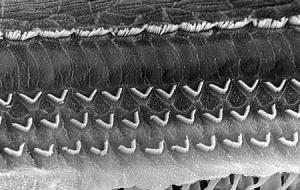
M. Lenoir
0) Normal aspect of the surface of the organ of Corti.
Basal turn of a rat cochlea.
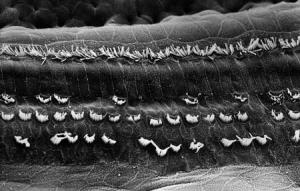
M. Lenoir
1) Initial stage of aminoglycoside intoxication.
The first row of OHCs is the most affected. Little damage can be seen in the 2nd and 3rd rows, and the IHCs are intact. In the clinical population, this level of damage would manifest as a light or moderate hearing loss accompanied by slight frequency discrimination problems.
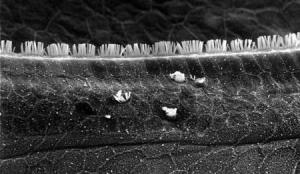
M. Lenoir
2) A higher dose eradicates nearly all OHCs, causing the loss of the cochlea’s active mechanism. The IHCs are still unaffected.
In a clinical population this level of damage manifests as a hearing loss of around 50-60 dB, and frequency discrimination is highly altered.
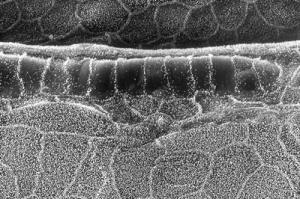
M. Lenoir
3) With a futher increase in dose IHCs have also been destroyed.
In this case, there is obviously a profound (complete) hearing loss.
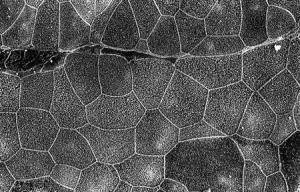
M. Lenoir

4)Total disappearance of the organ of Corti
After the disappearance of the hair cells, the supporting cells also undergo profound modifications. They form scar tissue throughout the space left vacant by the hair cells (see stages 2, 3).
In experimental animals, this stage occurs 2 months after stage 3.
In the last stage, the supporting cells become undifferentiated to form a flat epithelial layer
Pathology of stereocilia
Before the hair cells disappear completely, the stereocilia undergo drastic structural changes, such as fusion of ‘hairs’ (see left), and the formation of giant stereocilia (right). Images M. Lenoir
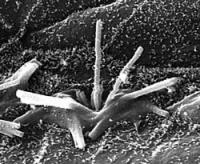
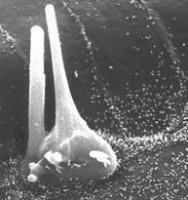
Note that antibiotic ototoxicity is currently well managed in adult subjects. However, it is important to always be vigilant during the period of cochlear development (i.e. 2nd term of pregnancy or premature babies), or where a subject is hypersensitive. In these cases, aminoglycoside doses that are inoffensive in adults can cause irreversible damage.
Mechanism of cell death
Hair cells affected by aminoglycoside antibiotics die by apoptosis.
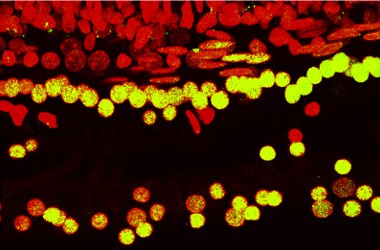
P. Vago
Immunofluorescence of a whole mount organ of Corti labelled with the TUNEL method for an organ of Corti damaged by amikacin. The nuclei of intact cells are labelled in red, and those with apoptotic cells are labelled in yellow.
Many sensory cells have already disappeared (first and seconds rows of OHCs), the majority of the remaining IHC and OHCs (third row) show an apoptotic nucleus.
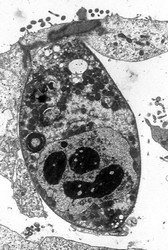
M. Lenoir
Degeneration of an OHC with a typical apoptotic nucleus (scanning electron microscope)
Macrophages
The disappearance of hair cells is accompanied by a response from cells of the immune system, characterised by a large macrophage invasion of the organ of Corti.
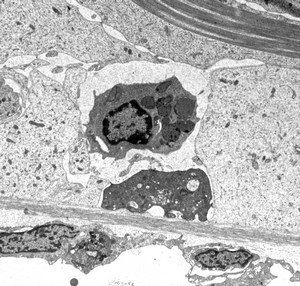
M. Lenoir – S. Ladrech
SEM. Two macrophages in the tunnel of Corti, blocked by cellular debris
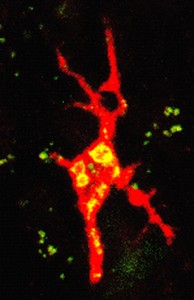
S. Ladrech – M. Lenoir
Immunofluorescence. A macrophage with double labelling for CD45 and ED1 in the tunnel of Corti.
Secondary effects in the nervous system
When an ototoxic antibiotic damages hair cells, the nerves within the cochlea are also affected. Progressive degeneration affects the Type I spiral ganglion neurons.
This degeneration begins with the unmyelinated terminals below the IHCs that undergo excitotoxic shock when the hair cell dies. Then, an axoplasmic degeneration can be observed in the fibers of the osseous spiral lamina and, finally, death (by apoptosis) of the spiral ganglion cells.
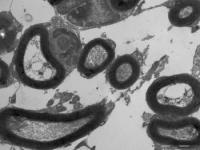
R. Pujol
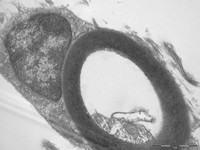
R. Pujol
15 [days]??? after neomycin treatment causing the disappearance of the IHCs, a degeneration axoplasmic is visible in some fibers of the osseous spiral lamina (linking the spiral ganglion neuron cell bodies to the IHCs).
The myelin sheath is perfectly maintained as can be seen in the image on the left, where a glial cell and the myelin sheath that it created surround an axoplasmic residue.
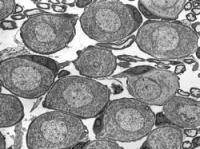
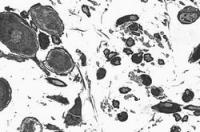
Compare the density of Type I neurons in a normal rat cochlea (left) and 2 months after ototoxic degeneration of the IHCs (right).
Species and age variability
The severity of the cellular loss varies depending upon the administered dose, but also the species and age of the subject. Therefore, guinea pigs are more sensitive to this kind of toxicity than rats, which are, in turn, more sensitive than mice.
In rats and mice, there is a critial period of sensitivity to aminoglycoside ototoxicity which is centered around the development of the compound action potential (CAP), i.e. around 11-12 days after birth in these species.